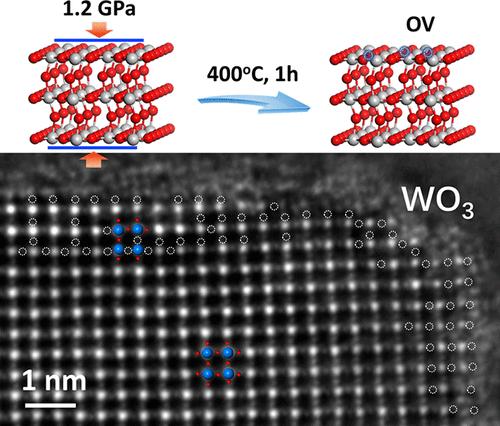压力诱导金属氧化物表面氧空位工程,促进异质光催化
IF 14.4
1区 化学
Q1 CHEMISTRY, MULTIDISCIPLINARY
引用次数: 0
摘要
本文章由计算机程序翻译,如有差异,请以英文原文为准。

Pressure-Induced Engineering of Surface Oxygen Vacancies on Metal Oxides for Heterogeneous Photocatalysis
Oxygen vacancies (OVs) spatially confined on the surface of metal oxide semiconductors are advantageous for photocatalysis, in particular, for O2-involved redox reactions. However, the thermal annealing process used to generate surface OVs often results in undesired bulk OVs within the metal oxides. Herein, a high pressure-assisted thermal annealing strategy has been developed for selectively confining desirable amounts of OVs on the surface of metal oxides, such as tungsten oxide (WO3). Applying a pressure of 1.2 gigapascal (GPa) on WO3 induces significant lattice compression, which would strengthen the W–O bonds and increase the diffusion activation energy for the migration of the O migration. This pressure-induced compression effectively inhibits the formation of bulk OVs, resulting in a high density of surface-confined OVs on WO3. These well-defined surface OVs significantly enhance the photocatalytic activation of O2, facilitating H2O2 production and aerobic oxidative coupling of amines. This strategy holds promise for the defect engineering of other metal oxides, enabling abundant surface OVs for a range of emerged applications.
求助全文
通过发布文献求助,成功后即可免费获取论文全文。
去求助
来源期刊
CiteScore
24.40
自引率
6.00%
发文量
2398
审稿时长
1.6 months
期刊介绍:
The flagship journal of the American Chemical Society, known as the Journal of the American Chemical Society (JACS), has been a prestigious publication since its establishment in 1879. It holds a preeminent position in the field of chemistry and related interdisciplinary sciences. JACS is committed to disseminating cutting-edge research papers, covering a wide range of topics, and encompasses approximately 19,000 pages of Articles, Communications, and Perspectives annually. With a weekly publication frequency, JACS plays a vital role in advancing the field of chemistry by providing essential research.

 求助内容:
求助内容: 应助结果提醒方式:
应助结果提醒方式:


